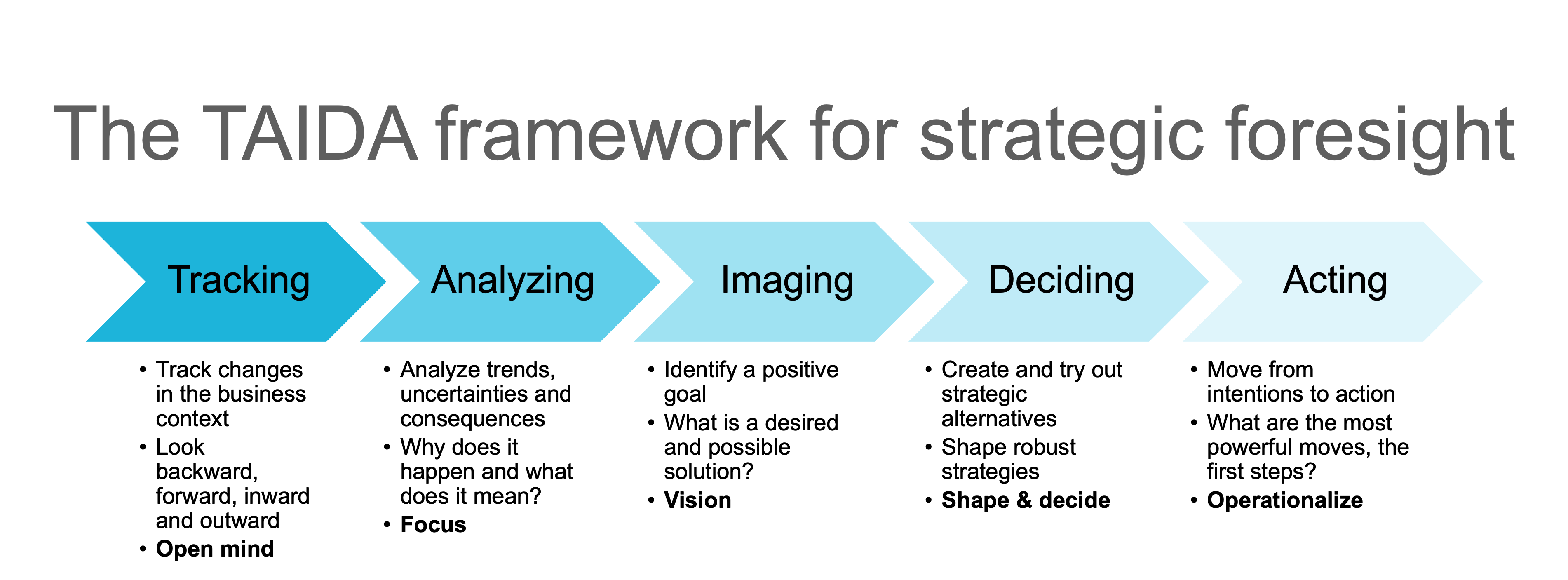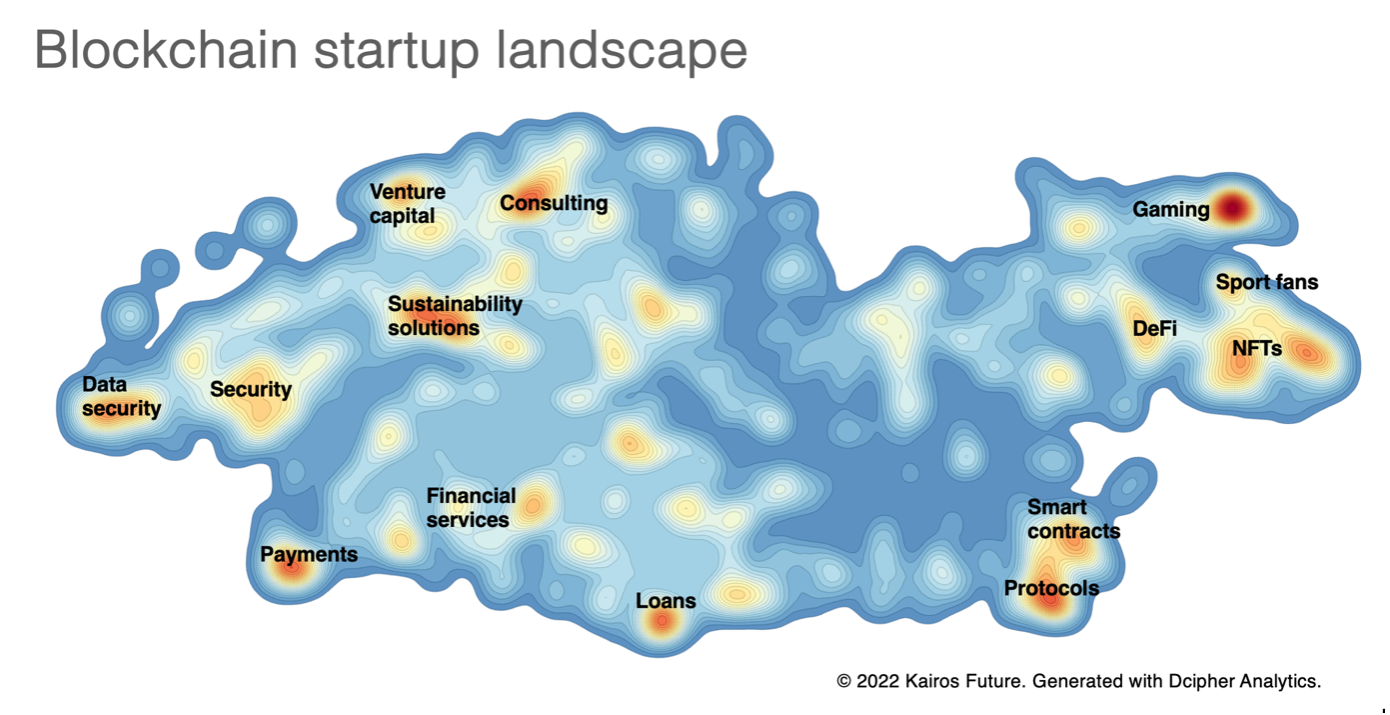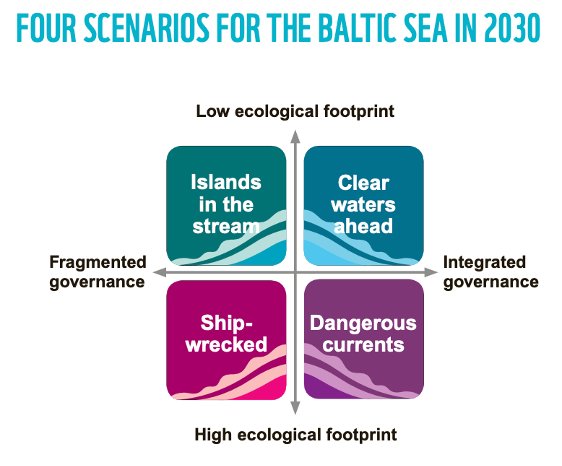Tracking and analyzing in a complex world: How to stay ahead of the curve
In the first article of this series, we explored how organizations can use the TAIDA framework for strategic foresight to prepare for uncertainty in an increasingly volatile world. Now, we take a closer look at the first two steps of the TAIDA framework — Tracking and Analyzing — and dive into the methods that organizations can use to monitor the external environment and analyze their findings for strategic decision-making. These steps are crucial for anticipating changes, capitalizing on opportunities, and avoiding disruptions. We explore how effective trend tracking and analysis can help you stay ahead of the curve and ensure long-term robustness. Let´s dive in!
Harnessing trend scanning and scenario planning to future-proof your organization

Fig.1 The TAIDA framework for strategic foresight. Click the figure for bigger size.
The importance of tracking: Navigating uncertainty through trend scanning
At the heart of tracking the changes and developments in the outside world is the ability to monitor the forces shaping your industry and affecting your organization in the long-term — whether it’s disruptive technologies, changing consumer expectations, or geopolitical shifts. In today’s fast-paced environment, having a system for scanning the horizon is more essential than ever. Tracking enables organizations to identify early signals of change and align their strategies accordingly. Today, if you want to stay ahead of the curve, this work cannot be limited to a yearly strategy update; it but must become a systematic and continuous approach embedded in daily decision-making.
What to track
In the tracking phase, the tools are used to help organizations identify the key areas of focus for their trend scanning. Examples of areas of change that concern most organizations include:
- Technological advancements: The rapid pace of AI development, automation, and digitization.
- Regulatory changes: Shifts in compliance and legal frameworks.
- Market dynamics: Evolving user and consumer behaviors and market trends.
- Social and environmental issues: Sustainability concerns and demographic shifts.
By systematically tracking trends in these areas, companies can better anticipate how changes will affect arenas of business in both the near and further off future.
Methodologies for effective trend scanning
While there are several approaches to scanning for change, some of the most effective methodologies include:
- Environmental scanning: This involves continuously monitoring the external environment for new trends. This method gathers intelligence from a wide range of sources—such as news outlets, market reports, and expert opinions—to capture a holistic view of the landscape.
- Horizon scanning: A more specialized form of environmental scanning, horizon scanning focuses on identifying weak signals and early trends that could have a significant impact on your organization in the future. This approach is especially valuable for spotting disruptive innovations before they gain traction.
- AI-Driven monitoring: Tools like Dcipher Analytics use artificial intelligence to analyze vast amounts of unstructured data, allowing organizations to track trends in real time and predict potential future developments. AI can automate much of the tracking process, freeing up time for strategic analysis.

Fig. 2 Example of AI analysis of blockchain startups. Click the figure for bigger size.
Analyzing: Turning data into actionable insights
Tracking trends is the first step in the process. The next step; Analyzing the data gathered during the tracking phase is where organizations can derive actionable insights. The Analyzing step in the TAIDA framework focuses on interpreting these signals through choosing and implementing different types of analyzes, in order to understand the potential implications of the signals for your industry and organization. Some examples of analyzes are:
1. Driving Force Analysis
- Purpose: To identify and understand the key forces driving change within a particular industry or market. This analysis uncovers the root causes behind trends, helping organizations determine what is shaping their environment and how it might evolve.
- Outcome: A clearer understanding of primary forces affecting strategic decisions, allowing organizations to focus on those with the highest likelihood of impacting their goals. For example, a driving force analysis in the automotive industry might reveal that electric vehicle adoption, climate policies, and battery technology advances are critical factors shaping the future.
2. Consequence Analysis
- Purpose: To anticipate the implications and downstream effects of specific trends or decisions on the organization. This analysis helps in understanding how certain developments might affect operations, strategy, and market position in both the short and long term.
- Outcome: Insights into potential challenges and opportunities, enabling organizations to create more resilient strategies. For example, if new regulations in the area of privacy law is expected, a consequence analysis could help organizations anticipate the operational changes and adaptations needed to ensure compliance.
3. Blind Spot Analysis
- Purpose: To identify areas that might be overlooked or underestimated within the organization’s current strategic planning, potentially posing risks or missed opportunities in the future. This analysis involves examining assumptions, biases, and commonly held beliefs within the organization.
- Outcome: By revealing blind spots, organizations can gain a more comprehensive view of the external environment and take proactive steps to address gaps in knowledge or planning. For instance, a blind spot analysis in a retail organization might uncover an underestimation of changing online consumer preferences, prompting a shift in e-commerce strategies.
Scenario Planning: Visualizing possible futures
One of the most effective ways to use trends in strategic decision-making is through scenario planning. Scenario planning helps organizations explore how different combinations of trends may shape the future. Scenario planning allows businesses to visualize multiple plausible futures and develop strategies that are robust in all scenarios.
In the process of scenario planning, organizations typically:
- Identify the most critical trends and uncertainties impacting their future.
- Develop a range of plausible scenarios that describe how the future could unfold.
- Analyze the impact of these scenarios on the organization’s strategic goals by wind tunnel testing.
Fig. 3 Example of scenario work by Kairos Future for the WWF (World Wildlife Fund). Click the figure for bigger size.
Preparing for the future with scenario planning
In a world where uncertainties abound, scenario planning allows decision-makers to prepare for a variety of potential outcomes. By thinking through different scenarios, organizations can:
- Develop new or adjusted strategies that may better meet the identified developments of for example value chains and market logic.
- Mitigate risks by preparing for less favorable outcomes.
- Identify new opportunities by exploring "what if" questions.
Studies from, among others, Shell—a pioneer in scenario planning—have shown that organizations that regularly engage in scenario planning are more resilient and better equipped to handle uncertainty. Verified data shows that organizations systematically using tracking and scenario planning see measurable benefits. These companies are more agile, better at anticipating change, and quicker to seize opportunities.
CONCLUSION: Embrace the future with confidence
Tracking and analyzing are essential steps in developing a future-proof strategy. By scanning the environment, understanding trends, and preparing for multiple possible futures, organizations can position themselves to thrive in an increasingly uncertain world. Stay tuned for the next article in this series, where we’ll explore how the later stages of the TAIDA framework—Deciding and Acting—can transform insights into concrete, actionable strategies.
Learn the tools – Become a Future strategist
Do you want to learn more about how to create foresight capacity-building in your organization?
Right now, we are accepting applications to the 2025 International Certified Future Strategist programme (ICFS), where we teach the toolbox of the TAIDA framework and develop participants into certified Future Strategists. As a Future Strategist, you can actively help your own organization, or client organizations, create preparedness for the future, and continued robustness towards the future. Contact the ICFS Course Director Nina Al-Ghussein Norrman to get an invite to the next ICFS information session, or book an individual session using this link.

